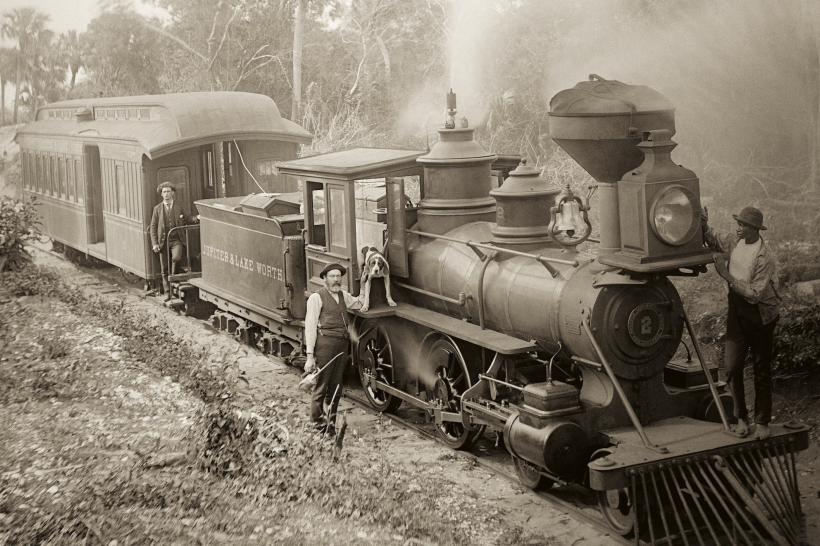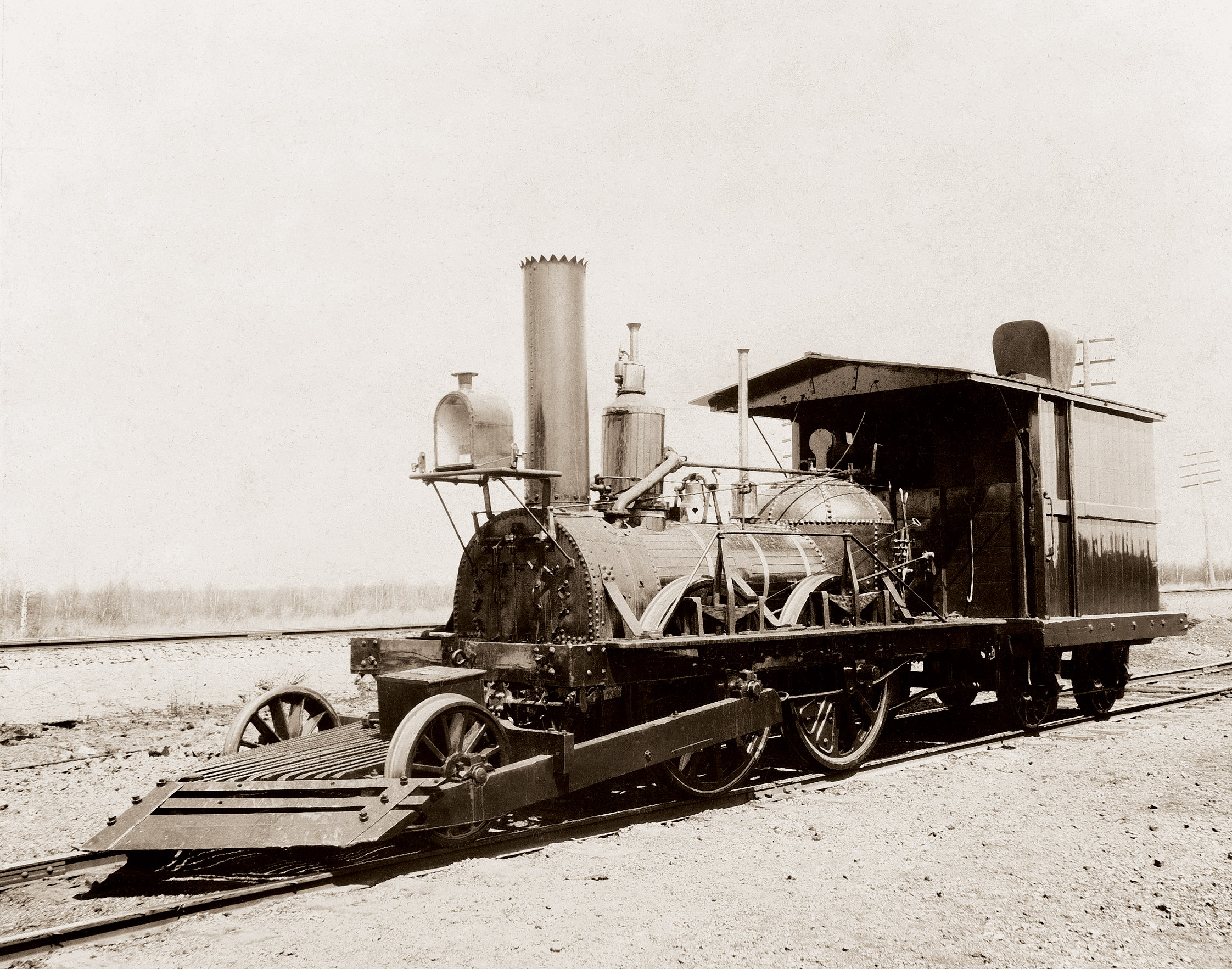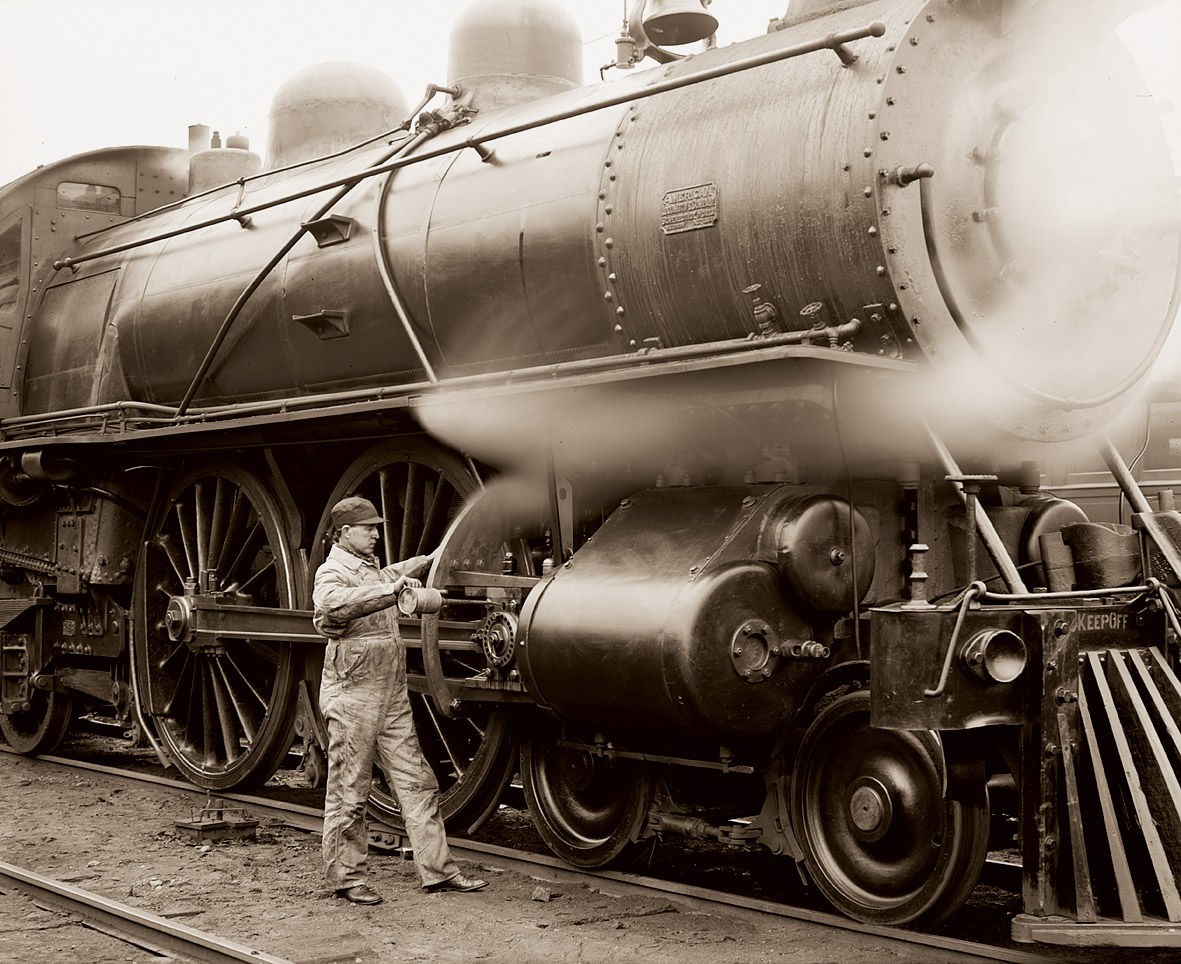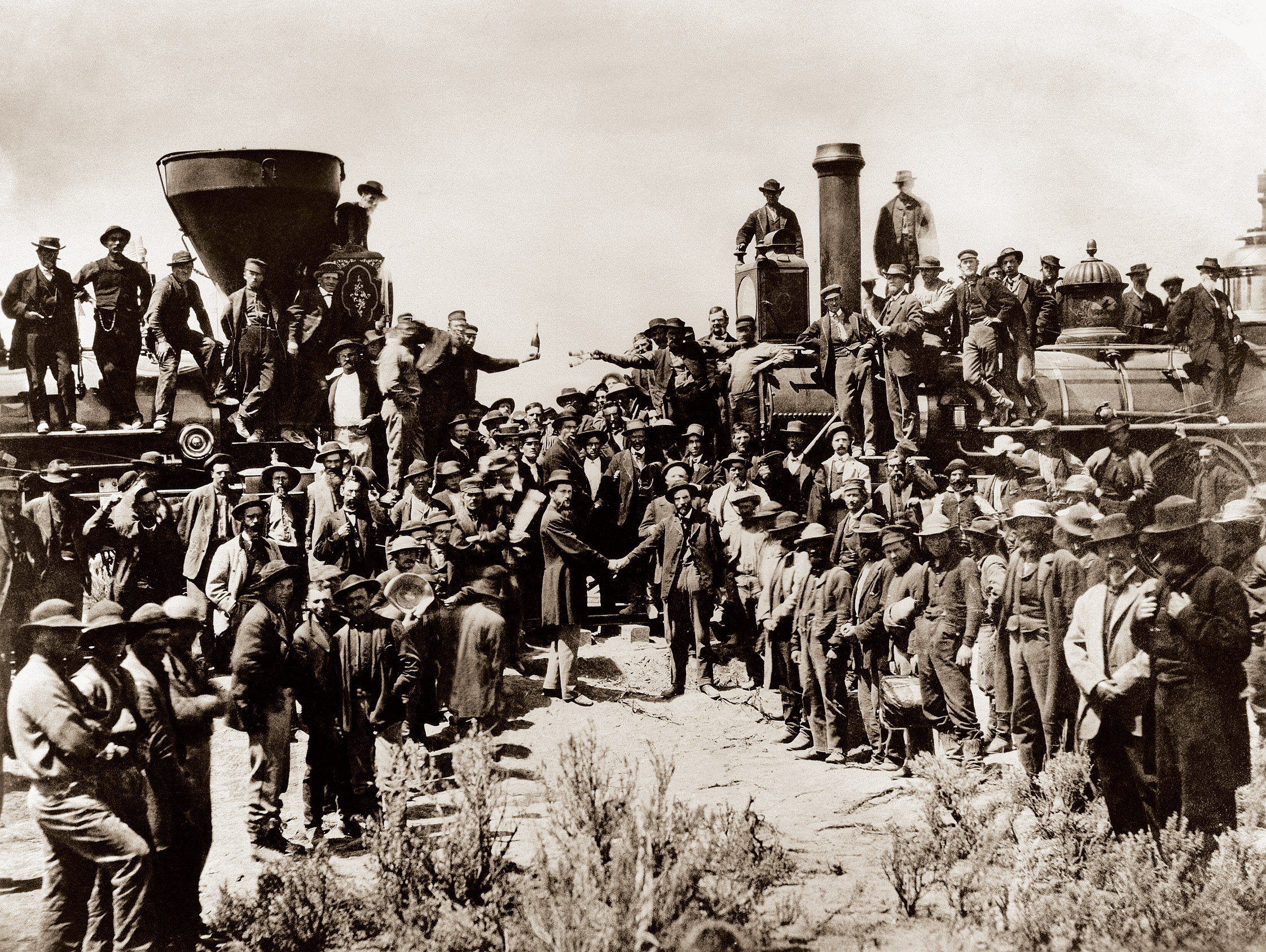
Na trasie amerykańskiej linii Jupiter&Lake Worth R.R - lata 80. XIX w.
Historia kolei
29 stycznia 2021

Na trasie amerykańskiej linii Jupiter&Lake Worth R.R - lata 80. XIX w.
Dlaczego człowiek potrzebował pociągu?
Rozwój kolei transkontynentalnej umożliwił ludności Stanów Zjednoczonych scalanie się w naród, a w Rosji w późniejszym czasie ułatwił przeprowadzenie rewolucji. Kolej stanowiła ważny element infrastruktury handlowej i przemysłowej na rozległych terenach kolonii w Afryce i Australii. Rywalizujące ze sobą narody europejskie dostrzegły strategiczne znaczenie pociągów już z chwilą ich wynalezienia. Potencjał nowej maszyny pozwalał ówczesnym inżynierom i technikom na wcielanie w życie śmiałych pomysłów.
Za rewolucyjne należy uznać zmiany, które zaszły w życiu codziennym ludzi za sprawą kolei. Łatwość komunikacji wymusiła wprowadzenie stref czasowych do życia społeczności, które do tego momentu synchronizowały zegary wedle własnych potrzeb lub zgodnie z cyklami wyznaczanymi przez pozycję Słońca. Rozwój kolei spowodował także, mniej widoczne na pierwszy rzut oka, przemiany w metalurgii, statystyce, fizyce, zarządzaniu. Postęp w technice kolejowej wpłynął na poszerzanie wiedzy w wielu dziedzinach, często na drodze rozmaitych eksperymentów. Przez ponad sto lat podstawą kolejnictwa była para wodna, węgiel zaś stanowił główne paliwo używane do jej wytworzenia. Wykorzystywano do tego celu także inne źródła energii: drewno, miał torfowy, łodygi trzciny cukrowej, odpady z produkcji bawełny oraz słomę, a od 1890 roku coraz częściej olej. Złoty wiek dla kolei przypada na okres między 1850 a 1920 rokiem, kiedy stanowiła ona główny środek transportu lądowego.

Parowóz "John Bull" - 1830 r.
Miliony pasażerów i miliony ton ładunków
Po 1830 roku rozwój kolejnictwa odbywał się błyskawicznie. Pociągi kursowały na coraz dłuższych trasach i w samej tylko Wielkiej Brytanii, w 1840 roku, linie kolejowe osiągnęły 3,5 tys. kilometrów. Rocznie przewożono nimi ponad 70 milionów pasażerów i miliony ton ładunków. W tym czasie trasy kolejowe zaczęto budować również w innych krajach Europy, chociaż początkowo nie decydowały o tym względy ekonomiczne. Kolej wprowadzano na życzenie panujących, jako nowinkę techniczną, umożliwiającą odbywanie niedzielnych wycieczek za miasto. Temu celowi służyła, np. linia Norymberga-Fürth, zbudowana w 1835 roku na polecenie króla Bawarii, linia Poczdam-Berlin, powstała z rozkazu króla pruskiego w 1838 roku, a także linie Petersburg-Carskie Sioło w Rosji i Wiedeń–Brno w Austrii. W inny sposób drogi żelazne powstawały we Francji. W 1830 roku grupa przemysłowców wyjednała zgodę administracji na budowę kolei konnej z Lyonu do Saint-Étienne, a po jej uruchomieniu, co odbyło się dwa lata później, kupiono w Anglii lokomotywy, stawiając władze i opinię publiczną przed faktem dokonanym.
Każdy chce mieć parowóz
W 1832 roku sprowadzono z Anglii do Stanów Zjednoczonych pierwszy parowóz. Był to słynny „John Bull”, jeżdżący w stanie New Jersey. Niebawem Amerykanie skonstruowali własną lokomotywę. W 1840 roku sieć kolejowa w USA liczyła już 4,5 tys. kilometrów, a 10 lat później zwiększyła się do 15 tys. kilometrów.
Korzyści, wynikające z wprowadzenia kolei, stały się oczywiste dla wszystkich. Przedłużano więc nie tylko stare linie w Anglii czy Stanach Zjednoczonych, lecz budowano nowe, zwłaszcza w krajach europejskich. W 1844 roku kolej uruchomili Duńczycy (na obecnym terytorium Niemiec) i Szwajcarzy. W 1848 roku kolej dotarła do Hiszpanii, w 1849 roku – do Szwecji (wąskotorowa), w 1854 roku – do Norwegii, w 1856 roku – do Portugalii, a w 1869 roku – do Grecji. W 1842 roku oddano do użytku pierwszą linię kolejową na obecnym terytorium Polski (Wrocław-Oława). Z kolei, w zależnym od Rosji, Królestwie Polskim budowę pierwszej linii kolejowej zainicjowano już w 1835 roku, czyli 7 lat przed powstaniem linii, na należącym do lepiej rozwiniętych Prus, Śląsku. Inwestycję zrealizowano jednak dopiero 14 czerwca 1845 roku, oddając podmiejski odcinek przyszłej linii Warszawsko-Wiedeńskiej (ukończonej w 1848 roku). Pod koniec XIX wieku długość linii kolejowych na świecie wynosiła już ponad 800 tys. kilometrów.

Oliwienie maszyny przed startem - USA, 1904 r.
Ponad sto zakładów i tysiące lokomotyw
W latach 30. XX wieku budową parowozów zajmowało się w Europie aż 125 zakładów. Niektóre z nich, np. fabryka Henschelund Sohn w Kassel, która rozpoczęła produkcję w 1848 roku, zatrudniały po 11 tys. pracowników, a rocznie wyjeżdżało z tych zakładów około 1000 lokomotyw. Angielska North British Loc Co. produkowała 800 parowozów rocznie, niemieckie fabryki Borsiga i Schwarzkopfa – po 600. Dwie fabryki amerykańskie: Baldwin i American Locomotive Co. wytwarzały po 3 tys. lokomotyw każda.
Sto lat dominacji
Trakcja parowa dominowała na kolejach przez prawie 100 lat. Zmiana nastąpiła z chwilą wprowadzenia trakcji elektrycznej i spalinowej. Szczególnie groźną konkurentką parowozu okazała się lokomotywa elektryczna. Zaprezentował ją po raz pierwszy – 31 maja 1879 roku na Wystawie Rzemiosła i Przemysłu w Berlinie – niemiecki konstruktor, Ernst Werner von Siemens. Była to niewielka maszyna o mocy zaledwie 2,5 kW, zasilana przy pomocy trzeciej szyny. Lokomotywę elektryczną szybko udoskonalono i już w 1881 roku przekazano do użytku pierwszy odcinek kolei elektrycznej na trasie Berlin-Lichterfelde. W 1903 roku na odcinku Berlin-Zossen lokomotywa elektryczna pobiła rekord prędkości, przebywając w ciągu godziny 211 kilometrów. Pierwszą zaś lokomotywę spalinową zademonstrował w 1891 roku inny konstruktor niemiecki – Gottlieb Daimler. Konstrukcję tę wprowadzono w Niemczech do użytku w 1912 roku.

Historyczny moment połączenia odcinków linii Union Pacific i Central Pacific - USA, 1869 r.
Para w cieniu elektryczności
Szybko przekonano się, że konkurentki parowozu, zwłaszcza lokomotywy elektryczne, są sprawniejsze, mają większą moc i znaczne osiągi eksploatacyjne. Są w stanie, bez uzupełniania paliwa i wody, przebyć długie trasy, nie trzeba ich obracać na stacjach zwrotnych i nie zanieczyszczają środowiska naturalnego. Te zalety zdecydowały o stopniowej rezygnacji z lokomotyw parowych. Wycofywanie trakcji parowej, w przypadku większości europejskich kolei, rozpoczęło się w latach 50. i 60. XX wieku. Zmalało wówczas zapotrzebowanie na parowozy, wiele fabryk zaprzestało ich produkcji. Natomiast w Stanach Zjednoczonych lokomotywy parowe wycofano już w latach 50. XX wieku, zaprzestając eksploatacji blisko 34 tys. tych pojazdów, w okresie od 1946 do 1956 roku.